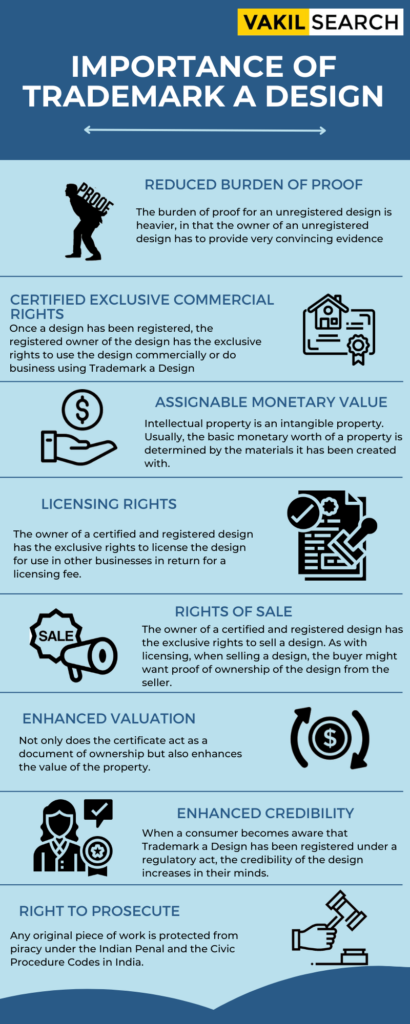In this article, we discuss the contribution of design to brand identity and why getting a design registered is important.A separate law for protecting the process to trademark a design came with the Designs Act, 2000. Designs are protected.
Overview:
The mention of intellectual property usually brings the words trademark, copyright or patent to mind. For a very long time, design was not given any prominence when it came to intellectual property. Although the very first intellectual property laws were brought in to protect textile designs and patterns, the protection of designs was divided between copyright laws and patent laws. In India, a separate law for protecting the process to trademark a design came with the Designs Act, 2000. This was ushered in by a series of international trade agreements signed by India as a member of the World Trade Organization. These agreements were almost exclusively centered around intellectual property, including protective rights for aesthetic design.
Hence, design and aesthetics have become the relatable factor that is increasingly being used for selling these products. Given that companies invest a lot of money on design research, the commercial framework of the economy is expected to provide some kind of protection to that kind of investment in the form of laws and regulations. In India, designs are protected by the Designs Act, 2000.
Definition of ‘Design’ Under The Designs Act, 2000.
Trademark a Design – The word design has been defined in the Designs Act under section 2(d). It states: ‘design’ means only the features of shape, configuration, pattern, ornament or composition of lines or colors applied to any article whether in two-dimensional or three-dimensional or in both forms, by any industrial process or means, whether manual, mechanical, or chemical, separate or combined, which in the finished article appeal to and are judged solely by the eye;
but does not include any mode or principle of construction or anything which is in substance a mere mechanical device, and does not include any trademark as defined in clause (v) of sub-section (1) of section 2 of the Trade and Merchandise Marks Act, 1958 (43 of 1958) or property mark as defined in section 479 of the Indian Penal Code (45 of 1860) or any artistic work as defined in clause (c) of section 2 of the Copyright Act, 1957 (14 of 1957).
Trademark a Design Act was passed much later than the other three acts.
- The Copyright Act was passed in 1957.
- The Trade Marks and Merchandise Marks Act was passed in 1958. And the
- The patents Act was passed in 1970.
Why it is important to bring this up in this context is to understand that the word ‘design’ means something in each of these three contexts. When it comes to Trademark a Design it means the design of a logo. When it comes to copyright, the word design can mean an artistic design or visual art. The patents act is not specifically mentioned because a patent design will be mechanical in nature and will automatically be disqualified as a design under this act as per the first half of the second part of the definition.
Registering a Design
The first step to registering a design is to conduct a search to ensure that the design is unique and has not already been registered. Once you have determined that the design is eligible for trademark protection, you can apply with the relevant government agency, such as the United States Patent and Trademark Office (USPTO). The application should include a description of the design and any images or sketches that can help illustrate it.
- Conduct a search: Before registering a design, it is important to conduct a search to ensure that the design is not already registered or being used by someone else. This can be done through online databases, such as the USPTO’s Trademark Electronic Search System (TESS), or through a trademark attorney.
- File an application: Once you have determined that your design is eligible for trademark protection and is not being used by anyone else, you can file an application with the appropriate trademark office. In the United States, this is the United States Patent and Trademark Office (USPTO). The application will require information about the design, such as a description and image, as well as information about the trademark owner.
- Examination: After the application is filed, it will be examined by a trademark examiner to ensure that it meets the requirements for trademark protection. This can include a review of the design’s distinctiveness and non-functionality.
- Publication and opposition: If the trademark examiner approves the application, it will be published for opposition. This means that anyone who believes the trademark registration would harm them can file an opposition to the registration.
- Registration: If no opposition is filed, or if the opposition is unsuccessful, the trademark will be registered, and a certificate of registration will be issued. The trademark owner can then use the registered trademark symbol (®) to indicate that the design is registered.
Types of Designs That Can Be Trademarked
Designs that can be trademarked include logos, symbols, emblems, shapes, patterns, and any other design element that can be used to distinguish the products or services of one business from another. To be eligible for trademark protection, the design must be unique and distinctive and not be too similar to any other designs that have already been registered.
Two types of designs can be trademarked:
- product designs
- logo designs
Design refers to the aesthetic appearance of a product or its packaging, which may include elements such as shape, configuration, pattern, ornamentation, or color. A design to be eligible for trademark protection, it must be distinctive and non-functional. Consequently, the design must be independent of the product’s function and sufficiently distinctive to identify its source.
Alternatively, logo designs refer to a symbol or design that represents a company or brand. Various elements, such as stylized text, shapes, colours, and graphics, can be incorporated into this. A logo must be distinctive and capable of identifying the source of the products or services with which it is associated to qualify for trademark protection.
In both cases, the design must be original and not infringe upon the intellectual property rights of others. The design must also be used in commerce to qualify for trademark protection. However, some designs are not able to be trademarked. These include designs that are considered to be functional, designs that could be more complex, or designs that are not used in commerce.
What Does the Process of Trademarking a Logo Involve?
Trademarking a logo involves several steps, including conducting a search to ensure that the design is unique and distinctive, filing an application with the relevant government agency, and responding to any objections or requests for additional information that may arise during the application process. Once the application has been approved and the trademark has been registered, the trademark owner can begin using it to protect their brand and prevent others from using similar designs to promote their products or services.
There are several steps involved in trademarking a logo, including:
- Prior to filing a trademark application, it is important to conduct a trademark search to ensure that the logo is not already registered or being used by someone else. It is possible to conduct this search through online databases or through the services of a trademark attorney.
- Once you have determined that the logo is eligible for trademark protection and is not being used by anyone else, you may file an application with the appropriate trademark office. A logo description and image, as well as information about the trademark owner, will be required for the application.
- A trademark examiner will examine the application after it has been filed to ensure that it meets the requirements for trademark protection. A review of the distinctiveness and functionality of the logo can be conducted as part of this process.
- In the event that the trademark examiner approves the application, it will be published for opposition. Consequently, anyone who believes they would be harmed by the registration of the trademark may oppose it.
- If no opposition is filed or if the opposition is unsuccessful, the trademark will be registered, and a certificate of registration will be issued. The trademark owner may use the registered trademark symbol (®) to indicate that the logo is registered.
What Does It Cost to Trademark a Logo?
Whether the application is filed online or offline, the cost of filing a trademark application in India can range from ₹4500 to ₹10,000. Trademark searches, oppositions, and renewals may also cost extra.
Depending on your legal services provider, the cost of trademarking a logo can also vary since they may have different fee structures or pricing models. Contact to get specific pricing information from Vakilsearch’s trademark registration services.
The cost of trademarking a logo varies depending on the country where the application is filed and the type of application being filed. In the United States, for example, the cost of filing a trademark application can range from $225 to $600, depending on the type of application being filed. There may also be additional fees for conducting a trademark search or responding to any objections arising during the application process.
How Long Does It Take To Trademark a Logo?
In India, the time it takes to register a logo as a trademark can vary depending on the logo’s complexity, the number of similar marks already registered or pending, and the trademark office’s workload. Generally, trademark registration in India takes 18 to 24 months, but it sometimes takes longer.
The length of time it takes to trademark a logo depends on several factors, including the complexity of the design, the number of similar trademarks already in existence, and the backlog of applications at the relevant government agency. Generally, the trademark registration process can take several months to over a year.
Importance of Trademark a Design

As per this act, in order for a design to be protected under the provisions of this act, the creator of a design must register the design with the designated authorities. Section 3 of the Act defines the ‘controller of trademarks, patents and designs’ to be the regulatory authority for the registrations of designs and the Patent office to be the regulatory institution for the design registration(Trademark a Design).
But it is important to note that even if a design is not registered, if a person can prove that a registered design has been copied or imitated from another unregistered design, the courts can strike down the rights of the imitated design, even if it has been duly registered.
So why is it so important to register a design? Let us take a look.
1. Reduced Burden of Proof –
- As discussed above, even though an unregistered product has equal protection from being pirated under the Indian Penal Code and the Civic Procedures Code, the burden of proof between a registered and unregistered design is not the same.
- The burden of proof for an unregistered design is heavier, in that the owner of an unregistered design has to provide very convincing evidence that proves beyond a reasonable doubt that his or her design is the original design.
- This means that the person has to provide date and time logs for the design, third-party witnesses, etc. which is very tedious to maintain.
- A registered design enjoys the confidence of the regulatory authorities given that the officers of the institution have done the necessary due diligence with regards to the originality of the product before granting it the registration certificate. Hence the burden of proof for a registered design is much lesser.
2. Certified Exclusive Commercial Rights –
- Once a design has been registered, the registered owner of the design has the exclusive rights to use the design commercially or do business using Trademark a Design in the manner prescribed by the Act for a period of ten years, extendable by five years on filing an application for extension.
- Considering the constantly shifting dynamics of design and aesthetics in general, ten years is a considerable amount of time to commercially exploit a design to its fullest.
- And even if the utility to Trademark a Design extends beyond the Validity of the design registration, ten years is enough time to create a unique association in the market for the design with the owner.
3. Assignable Monetary Value –
- Intellectual property is an intangible property. Usually, the basic monetary worth of a property is determined by the materials it has been created with.
- Then, additional monetary worth is added on top of this basic monetary worth by taking into consideration economic elements such as demand and supply.
- But how can you calculate the monetary worth of an asset which has no tangible form to determine even the basic monetary value? However, intellectual property is the only intangible asset that has been recognised to have monetary worth and international guidelines and parameters have been set by the World Trade Organisation and the World Intellectual Property Organisation on how to calculate the monetary worth of intellectual property.
- This means intellectual property can be sold, licensed or mortgaged in exchange for money.
4. Licensing Rights –
- The owner of a certified and registered design has the exclusive rights to license the design for use in other businesses in return for a licensing fee.
- Any person who wishes to enter into a licensing agreement for intellectual property will want to know that the person who is licensing the property is actually the owner.
- The certificate of registration, in this scenario, acts as an ownership document and reinforces trust in the originality and exclusivity of the design.
5. Rights of Sale –
- The owner of a certified and registered design has the exclusive rights to sell a design. As with licensing, when selling a design, the buyer might want proof of ownership of the design from the seller.
- And once again, the certificate of registration acts as proof of ownership of the design for the purpose of formalities.
6. Enhanced Valuation –
- Not only does the certificate act as a document of ownership but also enhances the value of the property.
- This is because, along with the aesthetic value of the design, the owner is also offering the buyer or the lessor the protective rights of exclusivity that the design enjoys as a protected design under the Designs Act.
- So the owner of the design can demand a higher price or licensing fees for his or her design.
7. Enhanced Credibility –
- When a consumer becomes aware that Trademark a Design has been registered under a regulatory act, the credibility of the design increases in their minds.
- This is because of the fact that any certification or registration provided by a government institution involves due diligence on part of the government.
- In other words, the government takes responsibility for the authenticity of the design. This creates public trust.
8. Right to Prosecute –
- Any original piece of work is protected from piracy under the Indian Penal and the Civic Procedure Codes in India. But when a piece of work is registered, the claim of the litigant carries much more weight given that the government has endorsed the design as an original and hence, indirectly, becomes a party to the case.
- Besides, the moment a design is published on the portal, it is a declaration that this design cannot be imitated and any imitation will invite judicial action. So the right to prosecute in the case of a registered design is a lot more explicit and apparent.
9. Residual Protection –
- As seen in the definition, design, under the design act, carries a very residual definition. This means all the designs that cannot be protected under the other three acts can be protected in the net of the Designs Act.
- For example, the copyright act allows only the code of the software to be registered under its provisions, i.e., only the code can be protected under copyright laws. But the interface cannot be protected under copyright laws.
- However, the interface can be protected under the Designs Act, thus allowing all aspects of the software to be protected, albeit, under different acts.
Conclusion
Trademark a Design under the act can be a tedious process. First, there are several factors that need to be examined in order to determine whether a design is eligible for protection. Then, the application form and the documents to be attached to the form can get a little technical as every one might not be familiar with the legal terminology used. And even after the registration, someone needs to constantly check the online portal to see if there are any new designs that they feel are similar to their Trademark a Design so an objection can be raised with the authorities. So it is always better to engage an expert in intellectual property laws when getting into the process of protecting your intellectual property. If you have any doubts or queries with regard to protecting your design or are looking for help registering your design, get in touch with vakilsearch and we will connect you with our team of highly experienced intellectual property law experts to assist you with your needs.










